Trina O’Quinn Reflects on Her New Personal Zen, the Art of Needlework, And Explains the Concept of Product vs. Process
By Trina O’Quinn for the NABBW
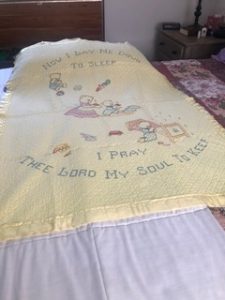
One of Trina’s hand-embroidered grandchild quilts.
One of the gifts of my retirement has been my resumption of needlework — specifically embroidery and quilting. Since I fully retired in November of 2019, I have embroidered, quilted, or both, daily. Before Covid, I made two baby quilts for my young grandson (now 6 years old) and young granddaughter (now 3).
As I sat embroidering the first quilt square in a new quilt for my middle granddaughter (now 22) I realized that something had changed in my time spent with stitching. I found myself asking why and how hand embroidery and hand quilting had become what seemed like my personal Zen?
- The movement of the needle became synchronized with the rhythm of my breath.
- As I pulled the needle up through the fabric from back to front, I took a full breath from the diaphragm, a singer’s breath, as I had learned from voice work.
- As I chose the stitch I would use and where it would be placed, I held this breath.
- Then as I pulled the thread back to the other side of the material I slowly exhaled. The inhale was to a count of 10, hold it to a count of 10, and then exhale to a count of 10. This is repeated though my 15–30 minute stitching session, usually 2-4 times a day.
- I became focused on my process and watched the world go by. Any thoughts I had went by like a teletype across a TV screen. All the while peace, calmness and joy became my state of being more consistently and frequently. I had developed a breath-focused practice of mindfulness meditation, in an intuitive way that made sense and worked wonderfully for me.
During my first year of retirement, I made many pictures, gifts, quilt squares and quilts for my family. This helped me adjust to a new way of life – being retired. Being still and knowing that I could enjoy this entirely new stage of life and way of being.
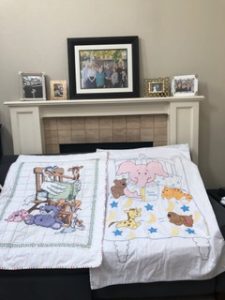
Examples of Trina’s embroidery skills.
I have been embroidering for most of my life. I first learned in Girl Scouts at a young age, as part of earning a badge. It began as a skill to create a product. This is how I gave gifts to those I loved: I decorated pillowcases.
When I married and was pregnant for the first time, I made my first baby quilt. It was stamped for embroidery and pre-quilted. I also made crib sheets and crib pillowcases.
As my friends and cousins became pregnant, I made them quilts, sheets, and pillowcases. Embroidering was still project focused, and quilting not yet really a skill. This continued until the middle 1970s, when I returned to school. What happened that made me stop?
- Embroidery and quilting were still project focused – getting something completed. I now had two school aged children, a husband, and homework from the classes I was taking to finish my Bachelor of Arts Degree in a year and a half.
- The birth of the women’s movement along with the Equal Rights Amendment was making its way through society. Needle work was considered women’s work, so many of us walked away from it. We avoided anything that was considered less than equal to men or limited to women. Many of us in our 30’s had been taught this skill in Home Economics classes, instead of being introduced to more vocational life skills as the boys had been. Needle crafts were now seen as the work of women, and stitching became a craft at best.
- It was something we were to do to be a good housewife. It was no longer considered art (if it had ever been). It was a woman’s chore or a mind filler, nothing more – just another chore along with looking after children, cleaning, cooking, and keeping a clean house. Many of us began to reject our needle skills or hide them from others. This was tragic. We didn’t teach our children. Needlework has been lost to a generation of people – a lost art.
The ramifications of this continue today, in that in certain parts of the United States, it is difficult to find supplies. Many of us order online from other states and countries. In the 1980’s there was a resurgence of the craft. Many needlework and fabric stores began to appear once again.
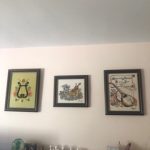
Some of Trina’s early embroidered pictures.
After receiving my B.A. I took some time off to catch up with myself and began stitching again. This time to decorate my home, for gifts, and to keep my hands busy. I was still project/product focused. From 1980-1982 I completed many pictures, and some are still on my walls today. Then, once again I returned to college to earn a Master of Arts Degree in Counseling Psychology and pass the California State Licensing Exam to be licensed as a Marriage and Family Therapist. From 1990 until 2019 I worked as a Marriage and Family Therapist with little time for the “nonsense of crafts.” My stash of embroidery and fabric sat in tubs, left to get old while the thread rotted.
In 2015 I retired from California State University, Dominguez Hills in Carson, California. For the first time in twenty-five years, I took some time to reflect on where I was in life. I was now 70 years old, still seeing clients in private practice. During this time of reflection my son and daughter-In-law announced that they were going to have their first child. Our family was growing once again. My husband suggested that I make a quilt for my new grandson.
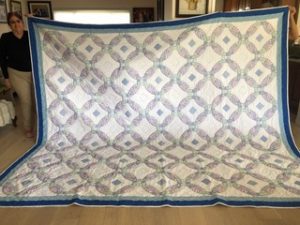
Trina’s double wedding ring quilt, a gift to her eldest granddaughter.
So, onto the Internet I went for a pre-stamped quilt top and then to the local needlework store for thread. As I began the quilt for our grandson, I was still project focused. As I began being productive again, I was inspired to finish the double wedding ring quilt I had started the year before for my eldest granddaughter.
In 2019 I closed my private therapy practice, fully retired, and my last granddaughter was born. To fill time, I started a quilt for her. Then during the Covid pandemic from 2020-2022, I finished my eldest granddaughter’s Double Wedding Ring Quilt. Three quilts later (grandson, baby granddaughter, and eldest granddaughter) I was still project oriented – focused on getting the project done, having a completed product.
As I began another baby quilt, I realized that things were slowly changing. As the thread began to cover the material, I began to see the art in it. As friends and associates commented on the amount of work involved, I realized that it wasn’t work at all. It was fun. It gave me peace and purpose. So began my journey of using embroidery and quilting to achieve inner peace. The surprise gift has been that I have met new friends that also enjoy the process of stitching. I have reconnected socially to a new group of women that see this as play and art.
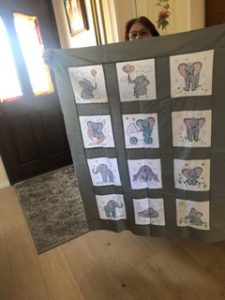
Trina shows off her block quilt featuring elephants.
I gradually moved to experiencing quilting and embroidery as a process I do every day. It is my time of meditation and focused breathing. It is my Zen, a road to inner peace. I still give some pieces as gifts when they are finished. I still decorate my home with the art I hand-create.
The difference is that in the doing I experience a peaceful process and a product that naturally results, in contrast with a pressured process focused on finishing a product. I have found a balance between quietude and movement. I now see a process that creates Art, as well as Inner Calm.
Perhaps there is some hobby in your life, whether new or old – some routine practice – that you could re-orient towards a process focused practice. Perhaps you could deliberately focus on your breath more of that time, instead of finishing the product, and begin to experience a meditative process. Is it perhaps gardening, cooking, wood working, music, or any other activity that can become process focused and a source of calm, quiet, and perhaps more joy.
Before she retired, Trina O’Quinn was an actively licensed Marriage and Family Therapist. Entering the profession as an older adult, Trina was in private practice for 30 years. During her career she was a lecturer at California University Dominguez Hills in the Marital and Family Therapy Program, where she supervised many students and mentored many associates.
Now retired from counseling, Trina keeps busy enjoying needle arts, reading, journaling and writing, as well as singing with a women’s chorus, peer networking, volunteering at a senior living center and reconnecting with old friends.


